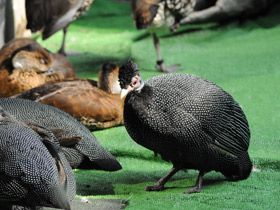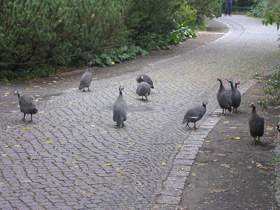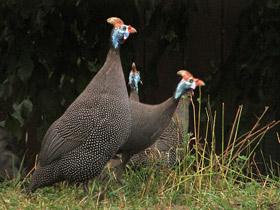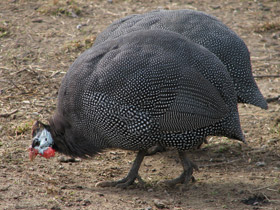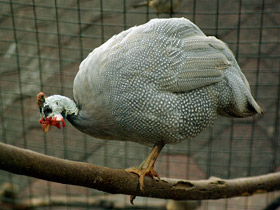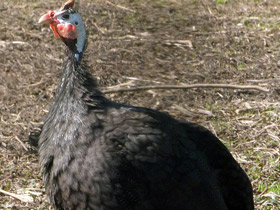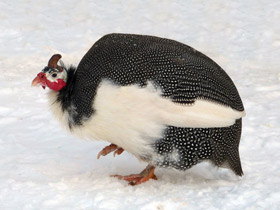The helmeted guinea fowl Numida meleagris
The appearance of these birds is typical for the Galliformes: the body and legs are of medium size, the neck is naked and relatively long. Like most Galliformes, all guinea fowl have various “decorations” presented by wattles and specific feather shapes. The helmeted guinea fowl are characterized by a dull yellow or reddish scimitar-shaped bony knob on the top of the head and red wattles on the chin. The head is almost featherless, the bill is slightly hooked and arched; the wings are short and rounded; the short tail is hidden under covert feathers. The naked upper chest and back of the head are lilac. The other body parts are covered with dark-grey feathers, with white round dark-edged spots. The species is found in Africa to the south of Sahara, and in Madagascar. Guinea fowl avoid forests and other dense vegetation, preferring dry forest-steppes with sparse plants. They feed on tubers, snails, insects, bulbs, berries, and seeds, which they find in savannahs, forest clearings, or farm fields. The helmeted guinea fowl breed during the dry season, so their young are highly susceptible to cold and damp weather. Adult birds are more resistant to temperature and air humidity changes. The guinea fowl live in flocks, with aggregations sometimes reaching several hundreds of birds, which warn each other by loud harsh calls, when alarmed. They are good runners and spend much time on the ground, flying only in emergency. However, at night they roost on tree branches. During the breeding period, the guinea fowl flocks divide into pairs, but it is only the female who is responsible for nest building, incubation, and brood-rearing. The nest is a simple depression in the ground. The clutch contains 6 to 19 small light brown eggs (which are somewhat smaller than eggs of domestic chickens). The eggs have strong and thick shell which provides a good protection against infections and temperature changes.
The guinea fowl were domesticated by humans. Domesticated helmeted guinea fowl are native to western and south-central Africa, from where they were brought to ancient Greece and Rome many centuries ago.

















